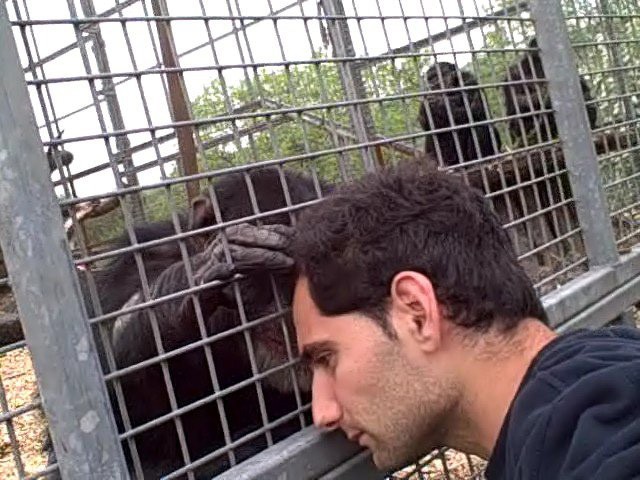Ape communication explored at Cornell event
By Linda B. Glaser
In a talk titled “Gestural Communication and Pantomime in Great Apes” March 6, evolutionary anthropologist Itai Roffman from the University of Haifa and three Cornell faculty explored the implications of the latest findings on primate culture and communication.
“This is profound and deeply moving research. It raises questions that by definition cannot be contained by any single science or discipline,” said co-organizer Cathy Caruth, the Frank H.T. Rhodes Professor of Humane Letters in the Departments of English and Comparative Literature.
“The enthusiasm that the current event created is a wonderful sign, I believe, of the sort of scholarly integration we could look for at Cornell,” added co-organizer Laurent Dubreuil, professor of Romance studies, comparative literature and cognitive science.
Genetically, chimpanzees are a sister species to humans, said Roffman, with 98.8 percent identical DNA. “Chimps are closer to humans than they are to gorillas and orangutans, which has moral and social implications,” he said. “Their facial expressions, survival strategies, body language and a whole suite of traits are similar to ours. We don’t need to look at the stars for aliens; we have intelligent nonhuman life here on Earth.”
Roffman compared chimps, who have meaningful informational exchange and tool-making capabilities, to early hominem species, noting that their meaningful mark-making and referential imagery is comparable to early cave paintings.
“The chimps in Mali use stone tools just like Lucy [an early human ancestor] did 2 million years ago,” Roffman said. “They inhabit cliff dwellings, build diverse nest types, including bamboo dome-shaped constructions with nests over them, thus exhibiting proto-architectural competencies. They also use bamboo to mark their trails and make junctions and, in so doing, map their territories.”
Chimpanzees have cultural diversity, and each group has its own customs, rules and norms, said Roffman. He and other researchers have found that nonhuman hominids (great apes) can remember experiences across time and talk about things that happened in the past, a requirement for giving valid testimony in a court of law.
In his response, Harry W. Greene, Cornell professor emeritus of ecology and evolutionary biology and a Stephen H. Weiss Presidential Fellow, raised questions about the ancestral characteristics of the evolutionary group that includes humans, chimps and bonobos, a topic he explored in “Evolutionary Scenarios and Primate Natural History,” published in 2017 in the American Naturalist.
“Archaeology has found material culture for three species other than human: chimps, capuchin monkeys and long-tailed macaques,” Greene said. He exhibited a spear, fashioned intentionally with a sharpened point, that was used by chimps to spear bushbabies.
In his response, Morten Christiansen, the William R. Kenan Jr. Professor of Psychology and co-director of the Cognitive Science Program, focused on how humans process and acquire language. “The brain doesn’t have a specialized language system,” he said. “Language piggybacks on many evolutionarily older systems in the brain.”
Language has been adapted to the specifics of our brains, he said, adding, “We should therefore not expect other species to easily pick up on human language because it may not fit the peculiarities of their brains.”
In his response, Dubreuil said the vocal repertoire of great apes is still dramatically undervalued.
“The few features of the vast, and certainly culturally defined, gestural repertoire in bonobos and chimps that have been deciphered already indicate … a capacity to share desires, actions or requests through gestures – as well as an aptitude to make their ‘body language’ iconic,” said Dubreuil. “This strengthens the possibility for such aptitudes to have been present, at least in some form, in our last common ancestor, roughly 5 million years ago.”
The event was part of a larger series of transdisciplinary activities at Cornell focused on communication in human and nonhuman animals, which included the Eloquence of the Apes workshop in October 2017; and a class on Culture, Cognition and the Humanities taught by Dubreiul and Christiansen.
A longer version of this story appears here.
Linda B. Glaser is a writer for the College of Arts and Sciences.
Media Contact
Get Cornell news delivered right to your inbox.
Subscribe

